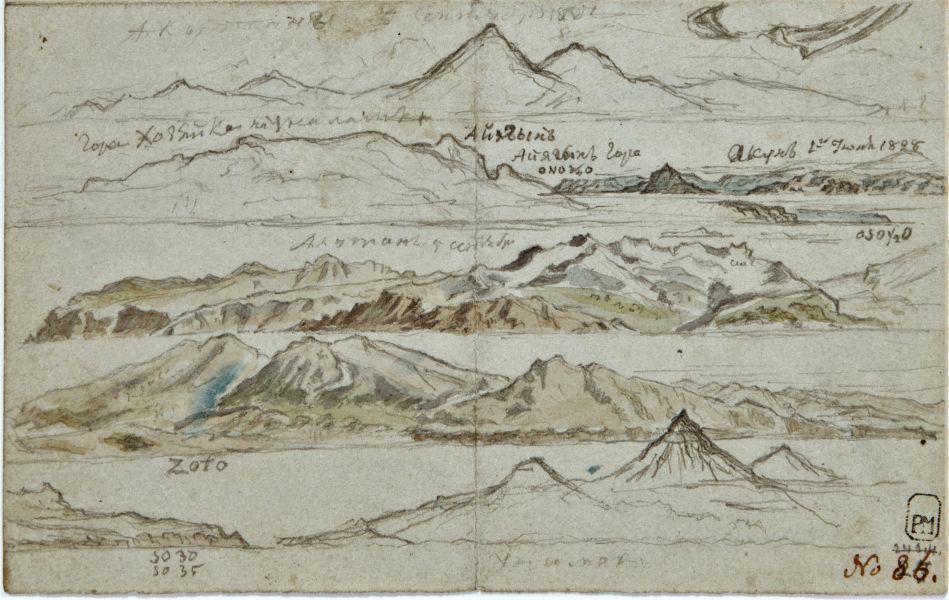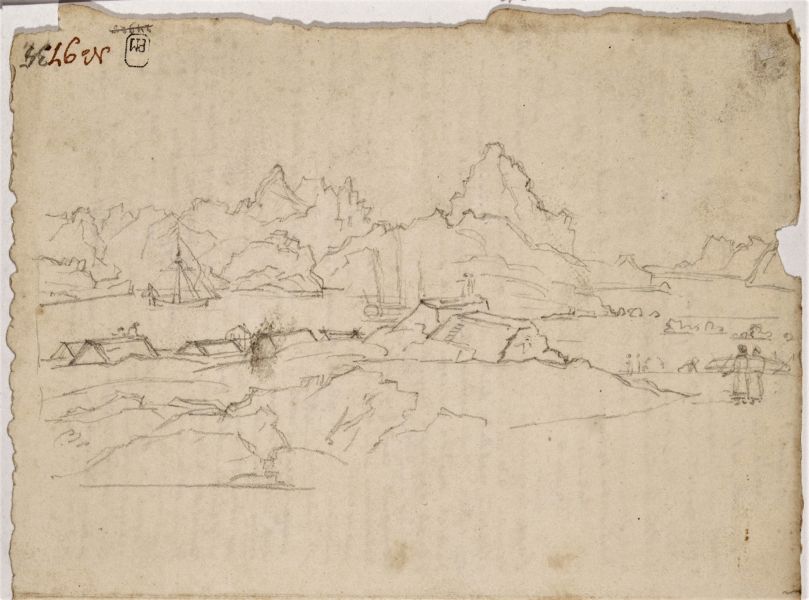A graduate of the Russian Academy of Art, Pavel Mikhailov (1786-1840) was one of very few Russian artists who participated in two round-the-world voyages. His first appointment as an expedition artist came ten years after he finished his course of study. In 1818, he was chosen to accompany the crew of F.F. Bellingshausen’s sloop Vostok on their voyage to the Antarctic, which did not include a visit to Alaska. This two-year long expedition was Russia’s first exploration of Antarctica, an event noted at the highest levels of Russian society. When the ship returned to Kronshtadt on July 24, 1821, the Emperor Alexander II honored the crew with his visit and “contemplated the rarities brought from countries that had not yet been visited by Russians, as well as a book of drawings by the expedition artist Mikhailov.” Many images created during this voyage were published in 1831 in the atlas accompanying Bellingshausen’s account of this voyage.
In 1826, Mikhailov was once again invited to participate in a round-the-world voyage. The naval sloop Moller, under the command of M.N. Staniukovich was tasked with delivering cargos to Okhotsk and Petropavlovsk and surveying the north-west coasts of America. The ship called at Petropavlovsk, Kamchatka, on June 18, 1827, and then set an easterly course, along the Aleutian chain, stopping in Sitka in September 21 for a month-long visit, before heading to Honolulu for the winter. Mikhailov’s Sitka portfolio includes multiple sketches of Tlingit objects and scenes of daily life, as well as portraits and landscapes, one of which – an unfinished watercolor of Sitka’s waterfront – shows nine ships on New Archangel roadstead, with their names marked above each image – providing unique information about the fleet of the Russian-American Company.
The Moller returned to Alaska in spring of 1828, calling at Unalaska and surveying the north coast of the Alaska Peninsula from Isanotskii Strait to the mouth of the Naknek River, and then setting course for a return voyage to Kamchatka. Mikhailov’s time ashore resulted in dozens of sketches, often executed on small card-deck size pieces of paper, used on both sides. More refined artwork from this voyage includes charcoal, sanguine and chalk portraits of people of the Aleutian Islands and Sitka. Trained as a portraitist, Mikhailov draws people, not ethnographic subjects, and his models carry full force of their personality.
The ship returned to Kronshtadt on August 23, 1829. Despite the significant volume of collected data, an official account of the expedition has never been published, partly because of the mutiny that broke out aboard of the Moller during the voyage. The authorities in charge wished to keep the matter quiet, and the results of the expedition saw very little attention. Instead, the government supported publication of Litke’s account on the Senaivin, which accompanied the Moller on a portion of the voyage. This had an unfortunate effect on Mikhailov’s life. After his return he was unable to secure another appointment or negotiate a state pension and died of tuberculosis in care of his friend, curator of the department of graphics of the Imperial Academy of Art A.G. Varnek. The collection left behind included 308 drawings and was purchased by the Academy of Art for one hundred silver rubles. Today it is split between several Russian and Estonian museums. In 2012, the Russian Museum in St. Petersburg, Russia, organized the first ever exhibit of Mikhailov’s work, accompanied by a catalogue with comprehensive list of all his known work.
Sources and Literature:
Solomatina, Natalia. Pavel Mikhailov: Voyages to the South Pole, 1819-1821, 1826-1829, The State Russian Museum, St. Petersburg, 2012.



















